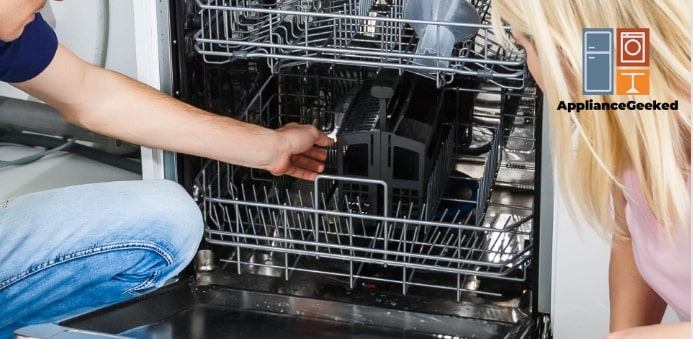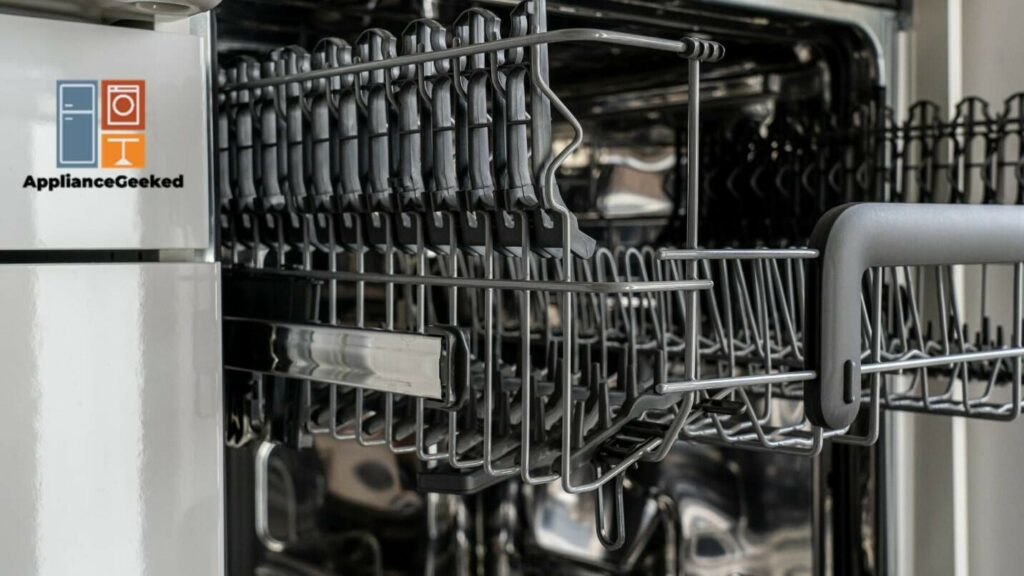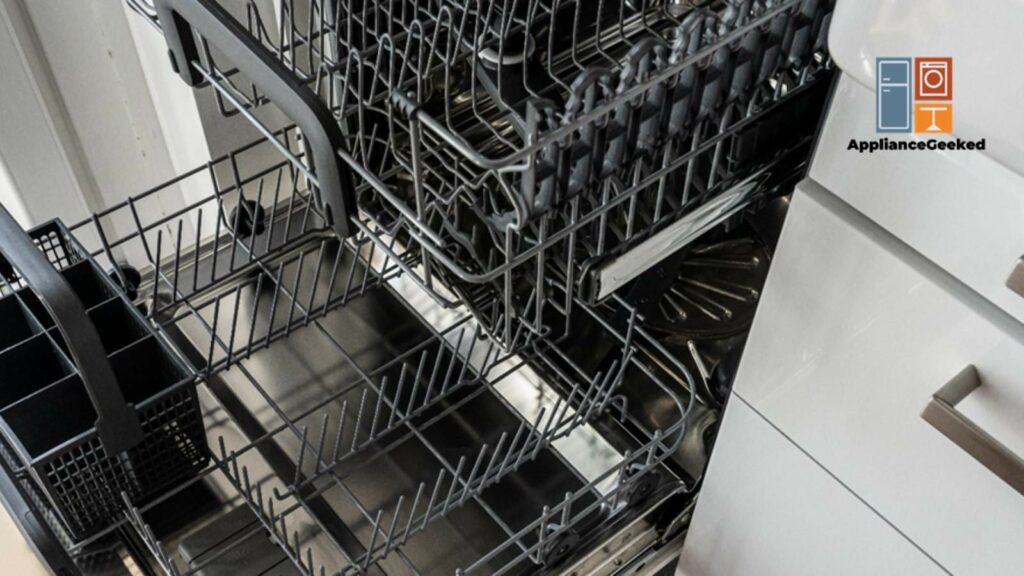Samsung dishwashers are designed to operate as quietly as possible. This is why hearing unusual noises in your appliance can be quite alarming.
So what causes your dishwasher to make noise and how do you fix it? Let’s jump right in!
Why is your Samsung dishwasher making noise?
The noise your Samsung dishwasher is making may be caused by the dishes bumping against the spray arm, a loose filter, a damaged drain pump, or a faulty door hinge.
Unplug your machine and reload the dishes correctly. Secure the filters, lubricate the hinges, and fix any damaged parts in the pump.
If these do not resolve the issue, you can also try the following methods:
- Make sure that the kick plate isn’t bumping against the dishwasher door.
- Wash the interior walls manually and remove any plastic and foreign debris.
If you need a detailed guide on how to carry out these steps, keep reading below.
Important Note: Unplug your dishwasher before performing any troubleshooting to avoid electrocution. Press the power button and make sure that your dishwasher no longer lights up.
Causes and Solutions
It is normal for your Samsung dishwasher to make some noise when operating. Here are some common sounds you may hear while your dishwasher is running.
| Normal Sounds | Causes |
| Water sounds | Water spraying |
| High-pitch sound | Water running in the pipes |
| Low humming or buzzing | Dishwasher is running |
However, loud and unusual sounds are indeed a cause for concern. If you hear one or more of the following sounds, you’ll need to address the problem quickly to avoid further damage.
Here are some abnormal noises to watch out for.
| Sounds Indicating Error | Causes |
| Tapping, knocking, crackling, or banging | Incorrectly loaded dishesUnsecured filter system |
| Loud humming, buzzing, or grinding | Clogged or damaged drain pump |
| Door squeaking, clicking, popping | Unlubricated door hingeElevated kick plate |
| Whistling or whining | Unclean dishwasher |
With that in mind, here’s a quick overview of how to troubleshoot each issue.
| Causes | Solutions |
| Incorrectly Loaded Dishes | Reload all your dishes and make sure that no item is sticking out of the racks. Nothing should be bumping into the water nozzles or spray arms. |
| Unsecured Filter System | Pull out the entire filter system and reassemble all the filters. Verify that they are positioned correctly and reinstall them back in the sump tightly. |
| Clogged or Damaged Drain Pump | Check the pump motor and impeller for any debris and signs of damage. Replace the entire assembly if necessary. |
| Unlubricated Door Hinge | Inspect the door and find out what is making the squeaking sound. Lubricate the hinge using a food-safe lubricant. |
| Loose Kick Plate | Check the bottom kick plate and make sure that it isn’t moving or wiggling during the cycle. Lower the kick plate towards the floor and verify that it doesn’t come in contact with the dishwasher door. |
| Debris Inside the Dishwasher | Clean your dishwasher and remove any plastic or debris at the bottom of the tub. |
Now, let’s take a closer look at each source of unusual noises and dive into the step-by-step guides on how to fix them.
Incorrectly Loaded Dishes
The most common reason your dishwasher is making an unusual sound is that some of the dishes inside are bumping against the water nozzles.
The sound may come from a pot handle, ladle, or knife that is sticking out of the rack and hitting a spinning water nozzle or a moving WaterWall reflector.
Small items such as bowls, saucers, or cutleries that are loosely placed on the racks could also move around inside your dishwasher and make an unusual noise.
Solution: Follow the steps below to load your dishes into the racks correctly.
- Step 1: Remove all the items in both racks.
- Step 2: Place all the items on the top rack if you’re only washing a few dishes. If you need to use both racks, make sure to plan ahead when placing the items inside your dishwasher.
- Step 3: Load smaller items, such as glasses, cups, saucers, and dishwasher-safe plastic dishes, into the top rack.
- Step 4: Place larger items, such as plates, pots, and other similar dishes, on the bottom rack. Make sure that the handles are not sticking out of the racks.
- Step 5: Use the cutlery basket for utensils. Position your knives with the handles up and your spoons and forks the other way.
- Step 6: If your model has a glass support rack, use it to load your stemware. Fold it back if you won’t be using it.
- Step 7: Make sure that small items are secured so they don’t bounce or fall off the rack during the cycle.
- Step 8: Test the water nozzles by spinning them to verify that nothing is blocking them.
- Step 9: If your dishwasher is using a WaterWall, peek underneath the racks, check the spray arm’s trail, and make sure that no items block its path.
Loose Filter System
Some Samsung dishwasher models have a removable filter system. This allows the user to take out the filter assembly and clean it regularly.
However, if the filter assembly has been installed or reinserted loosely, it may cause a tapping or knocking sound during the cycle.
The same can be said for a filter that has been damaged or deformed.
Solution: First, remove the filter assembly to inspect it for deformities. To do that, follow the steps below.
- Step 1: Remove the lower rack to access the filter assembly.
- Step 2: Hold the water nozzle and rotate the filter handle counterclockwise to loosen the filter compartment door.
- Step 3: Pull out the filter door and remove the filter below.
- Step 4: Disassemble the main filter, coarse filter, and fine filter.
- Step 5: Inspect each filter for damage and replace them if necessary.
- Step 6: Clean all filters in running water using a soft brush and mild soap.
- Step 7: Reassemble the filters and position them correctly.
- Step 8: Reinstall the filter door and rotate it clockwise to lock it in place. Make sure that the filter assembly isn’t loose.
Clogged or Damaged Drain Pump
The drain pump is responsible for draining all the wastewater inside the tub after the wash cycle. The drain pump forces the dirty water out with enough force to also prevent backflow.
Because of its function, the drain pump’s bearings wear out over time. A damaged bearing will weaken the drain pump motor and causes abnormal noises.
A low humming sound indicates that the drain pump is no longer able to power the impeller. A loud squeal means the drain motor’s bearings are already worn out.
Another likely cause of the drain pump making a grinding noise is debris caught inside its motor.
If a small piece of bone or glass has made its way to the drain pump, the impeller will have a hard time spinning and will cause an irregular sound.
Solution: Read your manual and check if the drain pump for your model can be accessed from the inside. If it is, then the drain pump is located right below the filter assembly.
Access your drain pump to verify if a clog or a damaged component is causing the noise.
Simply follow the steps above to uninstall the drain filter assembly and gain access to the drain pump.
If your model doesn’t have this option, perform the following steps to take out your drain pump for inspection.
- Step 1: Unplug your dishwasher. Press the power button and ensure that the panel doesn’t light up, which signifies that there is no more residual power.
- Step 2: Turn off the water supply valve.
- Step 3: Unscrew the bottom kick panel to remove it. Set it aside for later.
- Step 4: Place a towel or pan underneath to catch spills. Detach the water supply line from the inlet valve using a 5/8th inch wrench.
- Step 5: Unscrew the junction box cover and take it off. Remember the location of the wires to reconnect them correctly later on.
- Step 6: Untwist the wire nut and disconnect the wires.
- Step 7: Unthread the strain relief nut and remove it from the junction box.
- Step 8: Disconnect the drain hose from the garbage disposal or the sink drain. Feed the hose through the cabinet hole to pull the dishwasher out.
- Step 9: Pull your dishwasher out of the cabinet gently. Adjust the leveling legs down if necessary.
- Step 10: Slowly tip the machine back so that it’s resting on its rear panel. Make sure to move the drain hose out of the way to avoid damaging it.
- Step 11: Remove the access panel by unthreading its screws. Disconnect the leak sensor wire connector and set the panel aside.
- Step 12: Use a small flathead screwdriver to lift the locking tab. Slightly turn the drain pump counterclockwise to detach it.
- Step 13: Disconnect the wires from the drain pump and remove them.
Inspect the drain pump impeller for any debris and clean it using a soft brush. Look for any signs of damage and test the impeller to see if it can move freely.
Check the drain motor’s bearings. Replace the drain pump assembly if the bearings are deformed, broken, or too rusty.
Unlubricated Door Hinge
If you hear a squeaking sound when you open your dishwasher door, then it’s likely that the door hinges are faulty due to dirt build-up, rust, or damage.
A damaged door hinge will not only produce an odd noise but will also cause your dishwasher door to not close correctly.
Solution: Open your dishwasher door fully. Remove any dirt build-up on the hinges using a soft brush or a damp cloth.
Inspect the door hinges for damage. If they are working properly, lubricate them using food-safe lubricant.
If the door hinges are damaged, you’ll need to replace them. To do this, follow the steps below.
- Step 1: Unplug your dishwasher for safety.
- Step 2: Open the dishwasher door and unthread the front and rear screws.
- Step 3: Release the clips using a flathead screwdriver.
- Step 4: Remove the top lid of your dishwasher and set it aside.
- Step 5: Unscrew the side panel and pull it off gently.
- Step 6: Unthread the self-tapping screws to remove the front panel of the dishwasher.
- Step 7: Remove the insulation pieces, if your model has any, and set them aside.
- Step 8: Unclip the door spring off the hinge.
- Step 9: Unthread the screws holding the door hinge.
- Step 10: Close the dishwasher door to access the rest of the door hinge.
- Step 11: Use a flathead screwdriver to remove the clip holding the door hinge.
- Step 12: Pull off the old door hinge to fit the new one.
- Step 13: Screw the new door hinge in place and reinstall everything by performing the steps above in reverse.
Loose Kick Plate
The kick plate covers and protects the components under your dishwasher. However, if the plate is slightly elevated, it will hit the dishwasher door and cause a popping sound.
Similarly, if the kick plate is loosely screwed in place, it will keep shifting as you open and close the dishwasher door, causing a clicking noise.
Solution: Unscrew the kick plate and reposition it closer to the floor.
Check its distance against the dishwasher door and verify they are no longer bumping each other before screwing it back.
Reinstall the kick plate and make sure to screw it tightly in place.
Debris Inside the Dishwasher
If you hear a whistling or whining sound inside your dishwasher, there may be plastic or debris inside the tub that’s bumping against the wall or other parts.
Since a similar sound can come from water running through your pipes, you’ll know that this is the issue if the noise is still audible during a dry cycle when water is not running.
Solution: Unplug your dishwasher and take out all the removable items inside.
Wipe the interior wall with a damp cloth and remove any plastic, glass, or other foreign debris causing the issue.
Wash all the racks and other removable components before placing them back in.
Most of these noises can be solved easily by following the steps above.
However, if you’re hearing a different noise that we didn’t cover, we advise you to record the sound so a professional can have a frame of reference.
You can also go to the Samsung website and check the product page for your dishwasher model to learn about its normal working sound levels.




